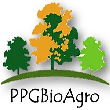Banca de DEFESA: DANIELA DOMÍCIA DA SILVA COSTA
Uma banca de DEFESA de MESTRADO foi cadastrada pelo programa.DISCENTE : DANIELA DOMÍCIA DA SILVA COSTA
DATA : 23/02/2022
HORA: 13:30
LOCAL: PPGBioagro
TÍTULO:
Insecticidal potential and anatomical and phytochemical characteristics of Apeiba tibourbou (Aubl.) leaves
PALAVRAS-CHAVES:
Bioinsecticides. Monkey comb. Botanical extracts. Leaf-cutting ants. aphids.
PÁGINAS: 78
GRANDE ÁREA: Ciências Agrárias
ÁREA: Recursos Florestais e Engenharia Florestal
SUBÁREA: Silvicultura
ESPECIALIDADE: Proteção Florestal
RESUMO:
The species Apeiba tibourbou (Aubl.) belongs to the Malvaceae family, is popularly known as monkey comb and balsa wood, and is widely used in folk medicine. Individuals belonging to the Malvaceae family have in their secondary metabolism a variety of chemical compounds that act in the defense mechanism against herbivory such as alkaloids, tannins and saponins. Understanding the physical characteristics and chemical compounds present in plants with insecticidal properties has been important for the development of new management techniques and new phytosanitary products with low environmental impact. In bibliographic research, there was a scarcity of data about the species Apeiba tibourbou, and its chemical and anatomical composition. The present work describes anatomical, histochemical and phytochemical characteristics present in the leaves of Apeiba tibourbou, and evaluates its insecticidal potential in the control of Aphis craccivora Koch (Hemiptera: Aphididae) and Atta sexdens L. (Hymenoptera: Formicidae). The phytochemical and histochemical analyzes and the anatomical description allowed the determination of the presence of starches, total lipids, phenolic compounds, alkaloids, mucilages, terpenoids and sesquiterpene lactones, calcium oxalates and trichomes. To evaluate the insecticidal potential of Apeiba tibourbou extract in adult individuals of Aphis craccivora, aqueous and hydroalcoholic extracts of leaves were prepared and subsequently applied at concentrations of: 2.5, 5.0, 7.5 and 10%. Survival assessment was performed at 24, 48, 72, 96 and 120 hours. There was a significant decrease in the survival rate of individuals, and the hydroalcoholic extract obtained better results than the aqueous extract. In the bioassays with workers of Atta sexdens, hydroalcoholic extracts were prepared from the bark and leaves of Apeiba tibourbou. The workers separated from the colony were placed in glass flasks, where the topical application of the extract was carried out, each repetition received a pad containing distilled water and an artificial diet cube based on agar and extract-free dextrose. Survival assessments were performed every 24 hours for a period of 15 days. There was a gradual decrease in the survival rate with increasing exposure time to hydroalcoholic extracts of bark and leaves of Apeiba tibourbou, showing to be a promising species for the control of Atta sexdens. Thus, the species Apeiba tibourbou has insecticidal potential in the control of Aphis craccivora and Atta sexdens in the laboratory.
MEMBROS DA BANCA:
Externo à Instituição - Caciara Gonzatto Maciel - UFRGS
Externo à Instituição - JARDEL BOSCARDIN - UFU
Presidente - 253817001 - JULIANA GARLET
Interno - 253995001 - VINICIUS AUGUSTO MORAIS



